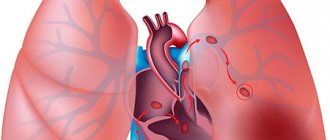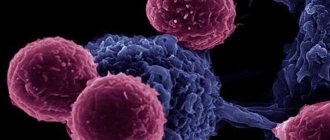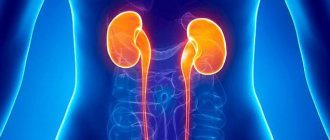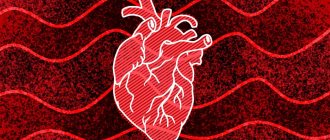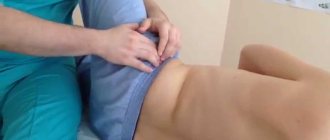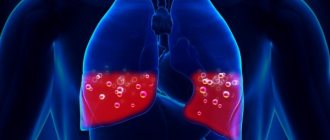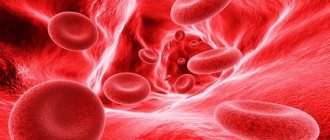Venous stagnation of the brain is a pathology manifested by excessive accumulation of venous blood in the venous system of the brain. Stagnation is characterized by the accumulation of metabolic products in the brain substance and a decrease in oxygen in the cells.
Venous congestion is not an independent disease, but the result of an underlying disease, for example, heart failure.
The outflow of blood may be disrupted from internal cavities, such as the sinuses of the brain, and external veins. The first option is rarely diagnosed due to its latent course. Impaired outflow from the superficial veins manifests itself by external signs, so the doctor notes the disease at the first contact.
Stagnation of venous blood leads to cerebral edema and increased intracranial pressure.
Symptoms of pathologies
Venous congestion in the head is diagnosed in people of different ages. The first thing you need to pay attention to is the nature of the headache. The pain is often dull in nature and often appears in the morning. The patient may experience difficulty getting out of bed. A person may feel like his body is weak, and he also feels very weak and lethargic. His condition especially worsens when the atmospheric pressure changes. Minimal stress, stress or drinking alcohol can re-ignite the pain syndrome. In addition to the headache, the patient experiences tinnitus, the capillaries in the eyes turn red and burst, and the lower eyelids may swell.
In addition to headaches, nausea and even vomiting may occur. When the condition worsens, there is a possibility of an increase in body temperature. Most signs of obstructed venous outflow are directly related to neurological pathologies. In advanced cases, a convulsive state of the limbs may appear, up to an epileptic seizure. There are cases when people fall into a coma. In this case, the patient will require constant medical supervision.
When venous thrombosis is diagnosed, patients experience severe swelling of the face, impaired consciousness may appear, and body temperature may rise.
Venous pressure with this diagnosis is often in the range of 55-80 mmH2O. Art., while the arterial blood is completely normal.
Classic symptoms of obstructed venous outflow include:
- Headache, often in the morning;
- Dizziness, worsens with a sudden change in body position;
- Fainting;
- Arms and legs often go numb;
- The skin of the face takes on a bluish tint;
- Darkness in the eyes and noise in the ears.
Exacerbation of classic symptoms occurs more often during spring and autumn. Patients feel better in summer and winter.
Stagnation of blood in the pelvic area
Venous congestion in this area refers to the passive form. It poses a great danger to the fair sex, since the disorder can provoke stagnation of blood in the uterus, and then lead to termination of pregnancy, the birth of a premature baby, or infertility. If the diagnosis was carried out in a timely manner and the therapy was chosen correctly, then it is quite possible to get rid of the disease.
In most cases, stagnation occurs in patients with an inactive lifestyle and due to sedentary work. Also, provoking factors include reasons such as:
- Heredity.
- Taking hormonal medications, birth control pills.
- Constant physical and psychological stress.
- The period of bearing a child.
Accompanied by stagnation in the pelvic area with “female” varicose veins.
How is it diagnosed?
Violation of the venous outflow of the brain should only be diagnosed by a doctor. Self-medication in this case is not only ineffective, but also life-threatening. First, the doctor must conduct a survey; it is important for him to determine the nature of the pain and the type of symptoms. For a detailed diagnosis, the patient may be referred to undergo the following examinations:
- MRI (detects any abnormalities in the functioning of the brain, the presence of neoplasms, consequences of injuries, the degree of vasoconstriction);
- Vascular ultrasound (helps determine the speed of blood flow, places of narrowing and blockage of blood vessels);
- CT scan (assesses blood circulation, determines the consequences of injuries and strokes);
- Angiography;
- X-ray of the skull (prescribed in the presence of brain injuries).
In addition to these studies, the patient may be referred for an examination of the fundus to an ophthalmologist, because there may be stagnation of blood in this area. All of the listed instrumental examinations help to see the whole picture of the disease, as well as determine the cause of its occurrence. Treatment of cerebral venous congestion should be carried out by either a neurologist or a vascular surgeon.
Provoking factors
Various factors can provoke this disorder in the human body, and by eliminating them, the condition can be normalized. The reasons for stagnation of venous blood include the following:
- Impaired performance of the cardiac and vascular system.
- Inactive lifestyle (physical inactivity).
- Problems with excess weight.
- Sedentary work.
- Poor, unbalanced diet.
- Taking certain groups of drugs.
- Hereditary factor.
- Impaired vascular tone.
- Psychological or physical stress.
- Complications in the postpartum period.
- Vein thrombosis.
Bad habits, heavy lifting, and standing work can also provoke stagnation.
How to improve churn?
To normalize venous outflow from the head and neck, complex treatment will be required, which will include a whole list of therapeutic measures:
- Taking medications;
- Massage;
- Phytotherapy;
- Diet;
- Regular training.
During the treatment process, one cannot ignore the normalization of sleep, as well as the abandonment of bad habits. Only a multifaceted approach to solving this problem will help strengthen blood vessels and normalize venous outflow.
Self-massage
Disruption of the venous outflow of the brain can be minimized with regular self-massage sessions. Anyone can do such simple movements, the main thing is to do them correctly and not to rush. Self-massage can be done twice a day. This procedure helps to relax the muscles and normalize blood flow.
First you need to take a comfortable sitting position, then you should learn to breathe correctly. Breathing should be calm and deep. Movements are carried out in the collar area. At first they should be in the form of light strokes to warm up the body a little. Next, you can make circular movements with your fingers around the neck. These movements should be spiraling towards the head. You also need to finish the massage with light stroking movements. Your doctor should tell you detailed self-massage techniques.
Exercises
To eliminate disturbances in the venous outflow of the neck and head, a whole range of useful exercises will come to the rescue. It takes no more than 10 minutes to complete, but if performed regularly, you will notice a noticeable result within 2-3 weeks. List of exercises:
- "Let's throw our heads back." First you need to sit on a chair with a hard back and seat. Throw your arms behind the back of the chair, tilt your head back, and completely relax your legs. It is worth fixing in this position for 1.5-2 minutes. After the time has passed, you need to walk around a little and then repeat the exercise again.
- “Making a long neck.” The main position is to sit on a chair, lower your head as far as possible towards your chest. As you inhale, gradually lift your head up. This movement should be done smoothly, but the gaze should be clearly directed to the ceiling. The neck must be pulled upward as much as possible. As you exhale, gradually lower your head to its original position. Carry out up to 8 such repetitions at a time.
- “Drawing 8.” Sitting position, relax your arms and legs, breathe calmly. You need to imagine that the top of your head is a brush that draws a figure eight in the air. You only need to rotate your head, without including your torso in the process. Draw circles smoothly, without sudden changes in head position. Repeat the exercise up to 6 times.
- “We do resistance.” The exercise is performed in a sitting position. Keep your back straight, place your hands under your chin with the backs of your hands. Inhaling, tilt your head forward, but at the same time resist with your hands. As you exhale, move your hands to the back of your head. The number of repetitions is 10-12.
If during the exercises you experience discomfort or the headache returns, then you should stop doing the gymnastics. It is advisable to perform such training daily, then not only will the blood flow normalize, but also pinching in the cervical spine will go away.
Medicines
With venous congestion in the head, you cannot do without taking medications. Venotonics are prescribed for therapy. This group of drugs not only improves blood flow, but also helps normalize the functioning of blood vessels. Taking such drugs is appropriate even as a preventive measure. Main properties of venotonics:
- Strengthen the walls of blood vessels;
- Reduce vascular fragility;
- Normalize microcirculation;
- Increase the overall tone of the veins;
- Improve their elasticity.
Medical drugs for the treatment of veins are produced both synthetically and using herbal compositions. The most famous plant-based venotonics are:
- Dr. Theiss;
- Antistax;
- Venarus;
- Troxerutin;
- Diosmin;
- Ginkor Fort;
- Getralex;
- Anavenol.
There are even preparations in the form of gels and ointments. Great demand is for:
- Gel Aescusan;
- Venen-gel;
- Ellon-gel;
- Cream Venoplast;
- Cream Gerbion.
In addition to the above medications, patients may be prescribed medications to prevent blood clots, such as Warfarin and Plavix. With this approach, the likelihood of developing a stroke is significantly reduced.
The treatment process cannot be done without diuretic compounds. Their task is to remove excess fluid from the body, reduce the amount of sodium, and normalize blood pressure. The following drugs are chosen for treatment:
- Furosemide;
- Lasix;
- Torsemide.
If the venous outflow of the brain is impaired, vasodilating drugs such as No-shpa and Cordaferon are also used for treatment. Only a doctor should select the range of drugs for treatment, taking into account the individual characteristics of the patient, his age, allergies, and contraindications.
Folk recipes
To normalize venous outflow, in addition to traditional treatment, you can resort to traditional medicine. But before using a prescription, you should consult a doctor; do not underestimate the power of herbs.
Folk recipes for combating improper venous outflow:
- Nettle juice. This plant can be consumed fresh, either in salads or as freshly squeezed juice. 1-2 glasses a day will be enough.
- Grape juice. The fruits of grapes strengthen the vascular walls, so during the grape season you can not deny yourself pleasure.
- Infusion of viburnum and ginkgo biloba. Take infusions every other day, alternating. An infusion of gingko biloba is easy to make. Pour 1 tablespoon of dry plant into a glass of boiling water. Leave for 20-30 minutes. An infusion of viburnum is made according to the same principle, only 2 tablespoons of fresh berries are taken per glass of water.
- Decoction of sweet clover. Pour 2 tablespoons of the herb into 200 ml of boiling water and simmer in a water bath for 15 minutes. Infuse the prepared broth for 40-50 minutes. take 100 ml 3 times a day.
It is better to choose a treatment method with alternative medicine together with a doctor, because it is important to exclude the possibility of developing allergies. If after drinking the prepared formulations your condition worsens, then you should stop experimenting with your health.
Diet
When the outflow of venous blood in the brain is disrupted, it is important to reconsider your diet. It is better to go on a diet that excludes all junk food. It is important during this period to strengthen the body’s immune forces, nourish the heart muscle, and normalize the blood circulation process.
The diet should not include fatty, too salty, smoked, sweet and fried foods. Foods rich in bad cholesterol are especially dangerous for health with this diagnosis. It is better to include foods rich in vitamin C and E into your menu. Do not forget about fiber, which is abundant in vegetables and fruits.
It is better to enrich the menu during treatment:
- All vegetables and fruits that are green;
- Flax seeds;
- Nuts;
- Berries;
- Fish;
- Seafood;
- Wheat germ.
It is better to give up fatty meats, baked goods, confectionery, sausages and preserves. Among vegetable oils, it is better to give preference to: flaxseed, olive, coconut, sesame, pumpkin.
Don't forget to drink water throughout the day. You should drink about 1.5-2 liters of pure water without gas per day. This volume does not include tea, juices, and compotes. It’s best to forget about alcohol and smoking altogether if you want to overcome the disease and prolong your life.
Stagnation of venous blood in the kidneys
Venous stagnation of blood vessels in this excretory organ can occur in several stages. The most severe is considered chronic. With it, there is an enlargement of the kidneys, as well as cyanosis and tissue compaction. Blood flow is disrupted and spasm of the renal arterioles occurs. With blood stagnation, glomerular filtration is limited, water-salt metabolism becomes worse, the plasma content in nearby tissue increases, and as a result, metabolism worsens.
Lymphostasis and stromal swelling may develop as the renal veins dilate and blood stagnates. With this pathology, the glomeruli enlarge and become full-blooded; as for the intercellular space, it expands.
Venous hyperemia in the kidneys is accompanied by complications such as:
- The formation of stones in this organ.
- Pyelonephritis.
- Inflammatory process.
- Increased pressure in the kidneys.
Treatment is based on eliminating symptoms and helping to prevent infection. It is recommended to take painkillers and antibacterial medications. To normalize blood flow, surgery is performed.
Prevention
In order not to encounter improper venous outflow of blood in the brain, it is necessary to lead a healthy lifestyle. Prevention of this disease is as follows:
- Quitting smoking, drinking alcohol;
- Consuming healthy foods, avoiding fried, sweet and fatty foods;
- Constantly undergoing preventive examinations;
- Walking in the fresh air at least 1-2 hours a day;
- When working sedentarily, do a minimal warm-up for your neck, arms and back every hour;
- To live an active lifestyle;
- Go to the pool, yoga, run in the morning, ride a bike;
- Completely cure infectious diseases;
- Avoid head trauma.
Brain pathologies caused by improper blood circulation are dangerous to health and life, so it is better to prevent them rather than treat them.
Share the article on social media. networks:
Venous congestion in the head
This pathology is secondary in nature and occurs as a result of any intracranial and extracranial disorders. Diagnosis of stagnation is based on pressure measurement, phlebography, as well as x-ray examination of the skull. If the patient has a chronic form of the disease, then there is impaired metabolism and oxygen starvation of the brain, resulting in tissue swelling, which, in turn, provokes increased pressure inside the skull. At the initial stage, there is a decreased tone of the veins, which can be determined using rheography.
Causes
Along with elderly people over 60 years of age, those at risk for pulmonary pathology include patients who have undergone operations, injuries, and those in the terminal stage of oncology. According to statistics, death occurs from stagnation in more than half of cases. Especially if the stagnation is caused by a condition such as pulmonary embolism.
Lung congestion most often occurs with congenital and acquired pathologies of the cardiovascular system, such as:
- cardiomyopathy;
- myocardial infarction;
- atherosclerosis;
- pericarditis;
- cardiac ischemia;
- stenosis of the mitral or aortic valves;
- arterial hypertension.
In addition, the reasons for the development of pathology may be:
- internal organ injuries;
- kidney diseases;
- long stay in high mountain areas;
- gas poisoning;
- taking certain medications;
- sedentary lifestyle.
Stagnation worries people who, due to age and concomitant diseases, are forced to lead a sedentary lifestyle. The accumulation of fluid in the lungs and alveoli prevents the full saturation of tissues with oxygen.
The disease may also be associated with heart failure, under the influence of the following factors:
- cardiomyopathy, pathology of the heart structure;
- hypertensive crisis;
- renal failure and vascular sclerosis;
- poisoning with chemicals through the respiratory system, taking medications, injuries.
